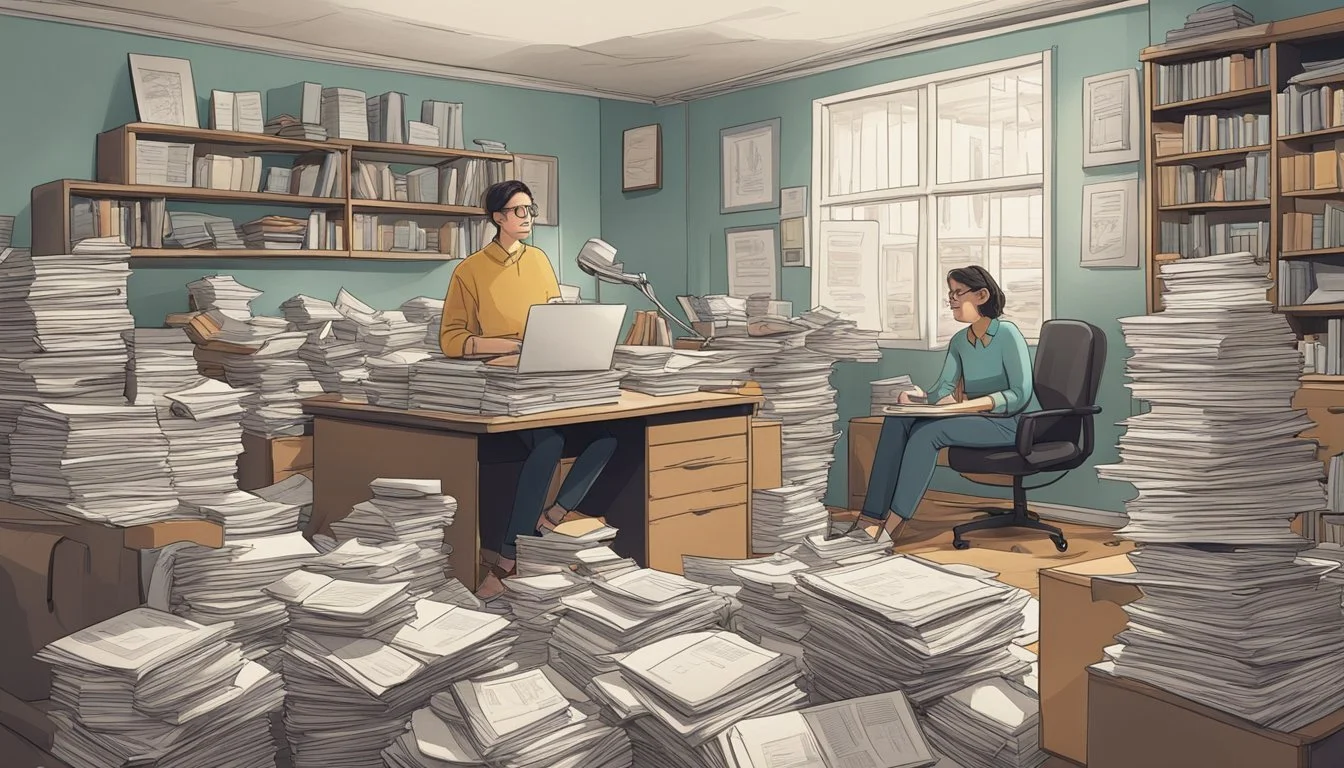Unlocking Recovery: Essential Hoarding Disorder Treatment PDF for Effective Care
Hoarding disorder affects millions of people worldwide, causing significant distress and impairment in daily functioning. This complex mental health condition is characterized by excessive accumulation of items and difficulty discarding possessions, often leading to cluttered living spaces and safety hazards. Cognitive-behavioral therapy (CBT) has emerged as a primary treatment approach for hoarding disorder, focusing on addressing underlying thought patterns and behaviors associated with excessive acquisition and difficulty discarding items.
Treatment for hoarding disorder typically involves a multi-faceted approach, combining therapy, skill-building, and sometimes medication. CBT sessions often include in-vivo interventions, where therapists work directly with clients in their homes to practice sorting, organizing, and discarding items. This hands-on approach helps individuals develop practical skills while addressing the emotional challenges associated with letting go of possessions.
Effective treatment plans also recognize the importance of building collaborative networks within communities. Mental health professionals, social workers, and local authorities often work together to provide comprehensive support for individuals struggling with hoarding behaviors. This holistic approach aims to address not only the psychological aspects of hoarding but also the potential safety and health concerns that may arise from cluttered living environments.
Understanding Hoarding Disorder
Hoarding disorder is a complex mental health condition characterized by difficulty discarding possessions and excessive acquisition behaviors. It can significantly impact a person's quality of life and relationships.
Definition and Diagnosis Criteria
Hoarding disorder involves persistent difficulty parting with possessions, regardless of their actual value. This results in the accumulation of items that clutter living spaces, making them unusable for their intended purposes.
Key diagnostic criteria include:
Excessive acquisition of items
Persistent difficulty discarding possessions
Cluttered living spaces that interfere with daily activities
Significant distress or impairment in functioning
The behavior is not better explained by other mental health conditions or medical issues.
Prevalence and Demographics
Hoarding disorder affects approximately 4-5% of the general population. It typically begins in adolescence or early adulthood but often goes unrecognized until later in life.
The condition tends to worsen with age, with symptoms becoming more severe in each decade of life. Studies have found that:
25% of elderly community-dwelling day care residents display hoarding symptoms
15% of nursing home residents exhibit hoarding behaviors
Hoarding disorder affects people across all socioeconomic backgrounds and education levels.
Psychological and Social Impact
Hoarding disorder can have severe psychological and social consequences. Individuals often experience:
Intense anxiety when faced with discarding items
Social isolation due to embarrassment about living conditions
Strained relationships with family members and roommates
Increased risk of falls and injuries due to cluttered spaces
Financial strain from excessive purchases and storage costs
The condition may also lead to legal issues, such as eviction or code violations. Many hoarders struggle with decision-making and organizational skills, which can impact their work and daily functioning.
Treatment often requires a multidisciplinary approach, addressing both the underlying psychological factors and practical aspects of decluttering and organizing.
Assessment Strategies
Accurate assessment is crucial for effective hoarding disorder treatment. Several key methods help clinicians evaluate the severity and specific manifestations of hoarding behaviors.
Clinical Interviews
Structured clinical interviews provide valuable insights into a patient's hoarding symptoms. Clinicians typically use the Structured Interview for Hoarding Disorder (SIHD) to assess diagnostic criteria. This tool explores difficulty discarding, clutter accumulation, and associated distress or impairment.
The interview process also uncovers triggers, emotional attachments to objects, and decision-making patterns. Clinicians probe the onset and progression of hoarding behaviors, often revealing important contextual factors.
Family members may be included to offer additional perspectives on the impact of hoarding. Their input can illuminate blind spots and provide a more comprehensive picture of the disorder's effects.
Questionnaires and Scales
Standardized questionnaires complement clinical interviews by quantifying hoarding symptoms. The Saving Inventory-Revised (SI-R) is a widely used 23-item self-report measure. It assesses three core dimensions: difficulty discarding, excessive acquisition, and clutter.
Other common scales include:
Clutter Image Rating (CIR): Uses photo references to rate clutter severity
Hoarding Rating Scale (HRS): A brief clinician-administered assessment
Activities of Daily Living in Hoarding (ADL-H): Measures functional impairment
These tools help track symptom changes over time and evaluate treatment progress. Clinicians often use a combination of scales to capture different aspects of hoarding behavior.
Home Visits and Observation
Direct observation of the living environment is essential for a comprehensive hoarding assessment. Home visits allow clinicians to:
Evaluate actual clutter levels and safety hazards
Observe decision-making processes in real-time
Assess the impact on daily functioning and quality of life
During these visits, clinicians may use the Environmental Cleanliness and Clutter Scale (ECCS) to rate different areas of the home. They also document specific types of clutter, patterns of item arrangement, and potential fire or fall risks.
Home-based assessments provide crucial context that may not be apparent in clinical settings. They help tailor treatment plans to address specific challenges in the patient's environment.
Treatment Modalities
Effective treatment for hoarding disorder involves multiple approaches tailored to individual needs. These modalities address the cognitive, behavioral, and emotional aspects of hoarding while promoting safety and functionality.
Cognitive-Behavioral Therapy
Cognitive-behavioral therapy (CBT) is a primary treatment for hoarding disorder. It targets the thoughts and behaviors associated with excessive acquisition and difficulty discarding items. CBT techniques include:
• Cognitive restructuring to challenge hoarding-related beliefs • Exposure exercises to practice discarding and resisting acquiring • Skills training for organization and decision-making • Goal-setting and problem-solving strategies
CBT typically involves 20-26 weekly sessions, often with home visits. Therapists may use specialized CBT protocols designed for hoarding. While effective for many, CBT appears to have more modest results for hoarding compared to other disorders.
Medication Management
Pharmacological interventions can complement psychotherapy for hoarding disorder. Medications commonly used include:
• Selective serotonin reuptake inhibitors (SSRIs) • Serotonin-norepinephrine reuptake inhibitors (SNRIs) • Stimulants for cases with attention deficits
These medications may help reduce anxiety, depression, and compulsive behaviors associated with hoarding. Dosages and combinations are tailored to individual needs and responses. Regular monitoring by a psychiatrist is essential to assess efficacy and manage side effects.
Harm Reduction Approach
The harm reduction approach focuses on improving safety and functionality rather than complete symptom elimination. Key elements include:
• Addressing immediate health and safety risks • Creating clear pathways in the home • Removing fire hazards and trip hazards • Improving sanitation and hygiene conditions
This approach is particularly useful for severe cases or when traditional treatments have limited success. It often involves collaboration with local health and safety officials, social services, and professional organizers.
Family Involvement and Systemic Interventions
Family-based interventions are crucial in treating hoarding disorder. These may include:
• Psychoeducation for family members about hoarding • Family therapy sessions to address relationship dynamics • Training family members in supportive communication • Involving family in decluttering and organizing processes
Systemic interventions also encompass community resources, such as support groups and multi-agency task forces. These collaborative networks can provide comprehensive care and support for individuals with hoarding disorder and their families.
Therapeutic Techniques
Effective treatment for hoarding disorder involves several key therapeutic approaches. These techniques aim to address the underlying causes and behaviors associated with hoarding, helping individuals make progress in managing their condition.
Motivational Interviewing
Motivational interviewing is a client-centered approach that helps individuals resolve ambivalence about change. It focuses on enhancing intrinsic motivation to tackle hoarding behaviors.
Therapists use open-ended questions and reflective listening to explore the client's thoughts and feelings about their hoarding. This technique helps build rapport and trust between the therapist and client.
The goal is to elicit "change talk" from the client, encouraging them to verbalize their own reasons for wanting to address their hoarding habits. Motivational interviewing can be particularly useful in the early stages of treatment when clients may be reluctant to engage fully.
Exposure and Response Prevention
Exposure and response prevention (ERP) is a cognitive-behavioral technique commonly used in treating hoarding disorder. It involves gradually exposing individuals to situations that trigger anxiety related to discarding items.
The process typically starts with easier tasks and progresses to more challenging ones. For example, a client might begin by sorting through less emotionally significant items before tackling more meaningful possessions.
During exposure exercises, clients are encouraged to resist the urge to acquire new items or keep unnecessary ones. This helps them learn to tolerate the discomfort associated with discarding and reduces anxiety over time.
ERP sessions often take place in the client's home, allowing for real-world practice and immediate application of skills.
Skill Building and Organizational Training
This component of treatment focuses on developing practical skills to manage clutter and prevent its recurrence. Clients learn strategies for organizing, categorizing, and maintaining their living spaces.
Key skills include:
Decision-making techniques for sorting items
Time management and task prioritization
Problem-solving strategies for tackling overwhelming clutter
Therapists may use hands-on exercises to practice these skills during sessions. Clients often receive homework assignments to reinforce learning between appointments.
Visual aids, such as organizing charts or labeled containers, can be helpful tools in this process. The goal is to empower clients with the ability to maintain an organized living environment long-term.
Supporting Self-Help and Peer Groups
Self-help and peer groups play a crucial role in treating hoarding disorder. These groups provide support, guidance, and shared experiences for individuals struggling with hoarding behaviors. They offer a safe space for learning coping strategies and making progress towards decluttering goals.
Creation and Facilitation
Self-help groups for hoarding disorder can be created through community initiatives or healthcare organizations. Facilitators may include mental health professionals, peer support specialists, or individuals who have successfully managed their own hoarding behaviors.
The "Buried in Treasures" workshop is a popular model for peer-led support groups. It uses a structured approach based on cognitive-behavioral therapy principles. Groups typically meet weekly for 15-20 sessions.
Facilitation involves guiding discussions, providing educational materials, and encouraging participants to set achievable decluttering goals. Facilitators help members develop action plans and offer support during the challenging process of letting go of possessions.
Effectiveness and Challenges
Research indicates that self-help and peer groups can be effective in reducing hoarding symptoms. A study on the "Buried in Treasures" workshop found it yielded an average 27.6% reduction in hoarding disorder symptom severity.
Peer support is particularly valuable. Individuals who have successfully managed their hoarding behaviors can offer practical advice and serve as role models for recovery.
Challenges in group settings may include:
Varying levels of readiness for change among participants
Difficulty in addressing individual needs within a group format
Potential for increased anxiety when discussing decluttering
To address these challenges, groups often incorporate individualized goal-setting and provide additional resources for one-on-one support when needed.
Aftercare and Relapse Prevention
Successful long-term management of hoarding disorder requires ongoing care and vigilance after initial treatment. Patients benefit from structured maintenance strategies and regular monitoring to prevent relapse and sustain progress.
Maintenance Strategies
Patients are encouraged to continue practicing decluttering techniques learned in therapy. This may involve setting aside regular time each week to sort through possessions and make decisions about what to keep or discard. Cognitive strategies help challenge unhelpful thoughts about acquiring or saving items.
Support groups provide opportunities to connect with others facing similar challenges. Some patients find it helpful to have an "accountability buddy" to check in with regularly about decluttering goals.
Stress management techniques like meditation or exercise can help reduce anxiety that may trigger hoarding behaviors. Developing meaningful hobbies and relationships is important for filling the void left by reducing acquisition of possessions.
Monitoring and Follow-Up
Regular check-ins with a therapist allow for early identification of any re-emerging hoarding tendencies. These sessions may be scheduled monthly or quarterly depending on the patient's needs.
Home visits by a therapist or trained professional can assess clutter levels and living conditions. Photos or videos of living spaces help track progress over time.
Patients are taught to recognize personal warning signs that may precede a relapse, such as increased difficulty discarding items or resurgence of acquisition urges. Having an action plan in place helps address these signs promptly.
Family members or friends may be enlisted to provide additional support and monitoring, with the patient's consent. Their observations can offer valuable insights into the patient's ongoing progress and challenges.
Multidisciplinary Approaches
Treating hoarding disorder effectively requires coordinated efforts from various professionals and community resources. A comprehensive approach integrates expertise across disciplines and leverages local support networks.
Collaboration Among Professionals
Mental health providers work closely with social workers, occupational therapists, and professional organizers to address hoarding behaviors. Psychiatrists may prescribe medications to manage underlying conditions like depression or anxiety. Psychologists often employ cognitive-behavioral therapy techniques tailored for hoarding.
Case managers coordinate care and ensure consistent communication between team members. Home health aides assist with daily living activities and maintaining a safe environment. Fire safety inspectors and code enforcement officers assess risks and provide recommendations.
Regular team meetings allow professionals to share insights, track progress, and adjust treatment plans as needed. This collaborative approach helps address the complex physical, emotional, and social aspects of hoarding disorder.
Integrating Community Resources
Local agencies and organizations play a crucial role in supporting individuals with hoarding disorder. Adult protective services may intervene in severe cases to ensure safety. Housing authorities can provide assistance with home repairs or temporary accommodations during cleanouts.
Support groups offer peer connections and shared experiences. Volunteer organizations may assist with decluttering efforts or provide emotional support. Libraries and community centers can host educational workshops on organization and decision-making skills.
Engaging family members and neighbors in the treatment process can create a supportive network. Legal aid services may help resolve tenancy issues or navigate court-mandated cleanups. Utilizing these community resources enhances the overall effectiveness of hoarding disorder treatment.
Legal and Ethical Considerations
Treating hoarding disorder involves complex legal and ethical considerations. Clinicians must balance patient autonomy with safety concerns and community impact.
Patients have the right to refuse treatment, but severe hoarding can pose health and fire hazards. This may necessitate intervention to protect the individual and others.
Confidentiality is crucial, but disclosure may be required if there are imminent risks. Clinicians should be familiar with local laws regarding mandated reporting.
Eviction and homelessness are serious risks for individuals with hoarding disorder. Practitioners may need to advocate for patients with landlords or housing authorities.
Informed consent is essential before any treatment or home visits. Patients must understand the potential consequences of both accepting and refusing interventions.
Capacity assessments may be necessary if hoarding severely impairs judgment. However, assumptions about decision-making ability should be avoided.
Collaboration with mental health professionals, social services, and legal experts is often required to navigate these complex issues ethically and legally.
Emerging Research and Future Directions
Recent studies are exploring new avenues for treating hoarding disorder. Researchers are investigating the potential of cognitive remediation therapy to address executive functioning deficits in individuals with hoarding tendencies.
Virtual reality exposure therapy is showing promise as a tool for helping patients confront their attachment to possessions in a controlled environment. This technology may offer a safer alternative to in-home interventions.
Neuroimaging research is providing insights into the brain mechanisms underlying hoarding behaviors. These findings could lead to more targeted pharmacological and neurostimulation treatments in the future.
Family-based interventions are gaining attention, recognizing the impact of hoarding on household dynamics. Early intervention programs for children and adolescents at risk of developing hoarding disorder are also being developed.
Researchers are examining the effectiveness of online and mobile app-based treatments to increase accessibility and engagement. These digital tools may help overcome barriers to traditional in-person therapy.
Community-based approaches involving multidisciplinary teams are being studied to address the complex needs of individuals with hoarding disorder. These collaborative efforts aim to provide comprehensive support and improve long-term outcomes.
Future research directions include:
Identifying biomarkers for early detection
Developing personalized treatment plans based on individual risk factors
Exploring the role of mindfulness and acceptance-based therapies
Investigating the potential of novel pharmacological agents





